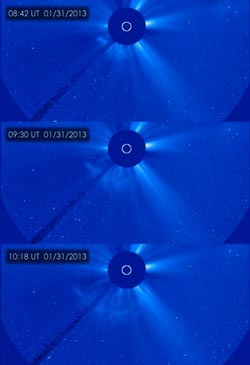A Coronal Mass Ejection Erupts From the Sun

The Solar and Heliospheric Observatory (SOHO) captured these image of a coronal mass ejection (CME), erupting on the left side of the sun early in the morning of Jan 31, 2013, as it was moving away from the sun into space. These images from SOHO are called coronagraphs, in which the bright light of the sun is blocked in order to make the dimmer structures in the sun's atmosphere, or corona, visible. Credit: ESA&NASA/SOHO<br>
Experimental NASA research models, based on observations from the Solar Terrestrial Relations Observatory (STEREO) and ESA/NASA’s Solar and Heliospheric Observatory, show that the CME left the sun at speeds of around 575 miles per second, which is a fairly typical speed for CMEs. Historically, CMEs at this speed are mild.
Not to be confused with a solar flare, a CME is a solar phenomenon that can send solar particles into space and reach Earth one to three days later.
Earth-directed CMEs can cause a space weather phenomenon called a geomagnetic storm, which occurs when they connect with the outside of the Earth's magnetic envelope, the magnetosphere, for an extended period of time. In the past, CME's such as this have caused auroras near the poles but didn't disrupt electrical systems on Earth or interfere with GPS or satellite-based communications systems.
NOAA's Space Weather Prediction Center (http://swpc.noaa.gov) is the United States Government official source for space weather forecasts, alerts, watches and warnings.
Karen C. Fox
NASA's Goddard Space Flight Center, Greenbelt, Md.
Media Contact
All latest news from the category: Physics and Astronomy
This area deals with the fundamental laws and building blocks of nature and how they interact, the properties and the behavior of matter, and research into space and time and their structures.
innovations-report provides in-depth reports and articles on subjects such as astrophysics, laser technologies, nuclear, quantum, particle and solid-state physics, nanotechnologies, planetary research and findings (Mars, Venus) and developments related to the Hubble Telescope.
Newest articles

High-energy-density aqueous battery based on halogen multi-electron transfer
Traditional non-aqueous lithium-ion batteries have a high energy density, but their safety is compromised due to the flammable organic electrolytes they utilize. Aqueous batteries use water as the solvent for…

First-ever combined heart pump and pig kidney transplant
…gives new hope to patient with terminal illness. Surgeons at NYU Langone Health performed the first-ever combined mechanical heart pump and gene-edited pig kidney transplant surgery in a 54-year-old woman…

Biophysics: Testing how well biomarkers work
LMU researchers have developed a method to determine how reliably target proteins can be labeled using super-resolution fluorescence microscopy. Modern microscopy techniques make it possible to examine the inner workings…





















